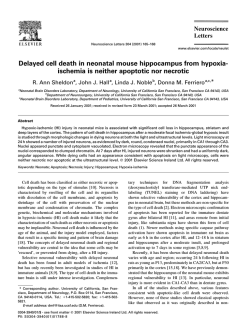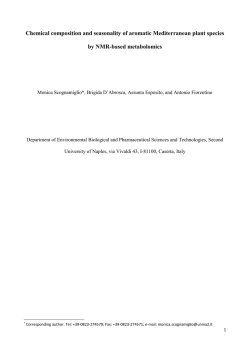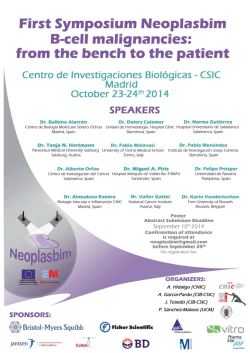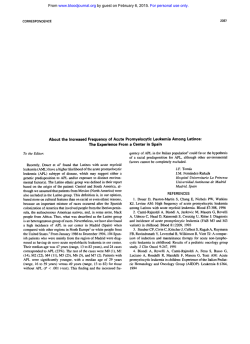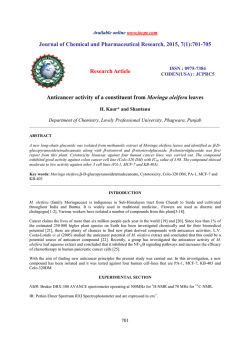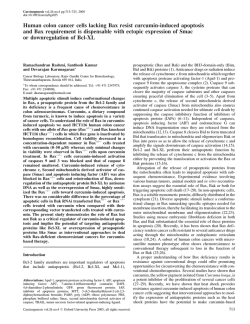
Anti-mutagenic and Pro-apoptotic Effects of
ORIGINAL REPORT Anti-mutagenic and Pro-apoptotic Effects of Apigenin on Human Chronic Lymphocytic Leukemia Cells Mehrdad Hashemi1*, Mehdi Nouri Long2, Maliheh Entezari1, Shohreh Nafisi3,4, and Hossein Nowroozii4 1 Department of Genetics, Islamic Azad University, Tehran Medical Branch, Tehran, Iran 2 Department of Medicine, Islamic Azad University, Tehran medical Branch, Tehran, Iran 3 4 Department of Chemistry, Islamic Azad University, Central Tehran Branch, Tehran, Iran Research Institute for Islamic and Complementary Medicine, Iran University of Medical Science, Tehran, Iran Received: 26 Dec. 2008; Received in revised form: 29 Apr. 2009; Accepted: 28 Jun. 2009 Abstract- Diet can play a vital role in cancer prevention. Nowadays the scientists are looking for food materials which can potentially prevent the cancer occurrence. The purpose of this research is to examine anti-mutagenic and apoptotic effects of apigenin in human lymphoma cells. In present study human chronic lymphocytic leukemia (Eheb cell line) were cultured in RPMI 1640 (Sigma), supplemented with 10% fetal calf serum, penicillin-streptomycin, L-glutamine and incubated at 37 ºC for 2 days. In addition cancer cell line was treated by and apigenin and cellular vital capacity was determined by MTT assay. Then effect of apigenin in human lymphoma B cells was examined by flow cytometry techniques. The apigenin was subsequently evaluated in terms of anti-mutagenic properties by a standard reverse mutation assay (Ames test). This was performed with histidine auxotroph strain of Salmonella typhimurium (TA100). Thus, it requires histidine from a foreign supply to ensure its growth. The aforementioned strain gives rise to reverted colonies when expose to sodium azide as a carcinogen substance. During MTT assay, human chronic lymphocytic leukemia revealed to have a meaningful cell death when compared with controls (P<0.01) Apoptosis was induced suitably after 48 hours by flow cytometry assay. In Ames test apigenin prevented the reverted mutations and the hindrance percent of apigenin was 98.17%.These results have revealed apigenin induced apoptosis in human lymphoma B cells in vitro. © 2010 Tehran University of Medical Sciences. All rights reserved. Acta Medica Iranica 2010; 48(5): 283-288. Key words: Antimutagenicity; antineoplastic agents; Leukemia Introduction Annually, an estimated 10 million people worldwide are diagnosed with cancer and approximately 6.2 million die from the disease (1,2). Cancer is a heterogeneous disease characterized by the growth of a malignant cell population leading to impairment of normal physiological functions (3). Tumor cells often have multiple alterations in their apoptotic machinery and/or signaling pathways that lead to increased levels of growth and proliferation (3,4). Over riding these mutations stimulates the apoptotic signaling pathway, leading to tumor cell death, which is a significant area of focus in anticancer drug research (5-8). Apoptosis, or programmed cell death, is an important mechanism through which multi-cellular organisms eliminate redundant, damaged or infected cells. It is energy dependent and requires specialized machinery. In such machinery, the death of the cell is produced by enzymatic degradation of different protein constituents, as opposed to necrosis, the other type of cell death (9). The dynamic balance of the immune system requires the complex regulation of proliferation, maturation, activation as well as elimination of lymphoid cells. Apoptosis is essential for controlling cell mass for immune response by deleting autoreactive lymphocytes and maintaining peripheral tolerance (10). According to the statistics almost more than 75% of cancers have an environmental origin (11,12). Genetic damages and changes in DNA sequences and genes mutations and other changes in chromosomal structure play an important role in cancer (13). Most of mutagenic and carcinogen agents display their destructive effects through free radicals including reactive oxygen’s species (ROS). So that antioxidants are able to reduce ROS. ROS have a role in etiology of diseases such as cancer, *Corresponding Author: Mehrdad Hashemi Department of Genetics, Faculty of Medicine,Islamic Azad University,Tehran medical branch, Tehran, Iran Tel: +98 21 22006660, Fax: +98 21 22008049, E-mail: [email protected] Antimutagenicity and apoptotic effects of apigenin on chronic lymphocytic leukemia cells cardiovascular disease, nerves problems and senescence. So daily consumption of antioxidants enhances immunity of the body against free radicals production and serves as anticancer agent (14,15). Many studies report that a diet high in fruits and vegetables lowers the incidence of cancer (16–18). Flavonoids are a ubiquitous group of polyphenolic compounds found in fruit, vegetables, seeds, nuts, herbs, flowers, tea, and coffee. The biochemical activities of flavonoids depend on their chemical structure and the relative orientation of various moieties on the molecule (19-24). Over 5000 different flavonoids have been described to date, and they are classified into at least 10 chemical groups and are categorized as flavones, flavonols, flavonones, anthocyanins, and isoflavones commonly found in our diet. Flavonoids exhibit extensive bioactivities such as anti-inflammatory, cardiovascular, scavenging free radical, lowering blood pressure, antitumor, antispasmodic, antidiarrheal, and antiproliferative activities (25). Apigenin (40,5,7-trihydroxyflavone) is a cancer chemopreventive agent. It inhibits cell proliferation in cancer cell types and reduces the number and the size of skin tumors that develop in response to chemical carcinogen or UVB exposure via a mechanism involving inhibition of rnithine decarboxylase activity (26-27). Ames test is one of the most current test to assay anti-mutagenic effects using bacteria with special mutants (28,29) and the material is used on cancerous cells in vitro. This research has been tried to consider anticancer effects of apigenin on cancerous cells and also through Ames test. Patients and Methods In this research, the method of vital capacity test (MTT) has been used in order to consider cytotoxicity of apigenin on cancerous cell lines (in vitro) and results have been calculated in terms of stimulation index and assessed by t-test. Ames test has been used as a current method to assess antimutagenesis effect of apigenin on mutant bacteria, Salmonella typhimurium, and results have been assessed by one way-ANOVA followed by the Duncan post hoc test on the basis of bacterial colonies in selected conditions. Cell culture of human lymphoma cells Human chronic lymphocytic leukemia (Eheb cell line) was cultured in RPMI 1640 medium supplemented with 10% FBS, 100 units/ml of penicillin, and 100 mg/ml of streptomycin. The cell line was maintained at 37 ºC in an incubator with an atmosphere of 5% CO2. After counting, almost 5000 cells transferred to flasks. 284 Acta Medica Iranica, Vol. 48, No. 5 (2010) In any cases, 3 flasks have been considered for each test with 3 repeats for all tests. MTT staining In this technique, color effect of MTT (dimethylthiazol diphenyl tetrazolium bromide) on cells has been used in which living cells, contained purple crystals as a result of color reduction by mitochondrial dehydrogenase of alive cells, would be countered and alive cells percentage would be determined by the following formula: Viability= (alive cells number/ whole cells cultured) ×100 After 18 hours in order to full adherence of cells to the plate, different concentrations of apigenin (0 as control, 5,10,15,20 μg/ml) have been added to cells and plates were incubated for 48 hours at 37 ̊C and ۵% CO2. MTT staining is on the basis of MTT reduction into an insoluble blue-purple product (Formazan) by mitochondrial reductase in living cells. MTT solution contains 50 mg MTT powder in 10 ml PBS (0.15 M) which has been diluted by 10 times with PBS to get 0.5 mg/ml solution of MTT, and then the solution was autoclaved. After 48 hours incubation of cancerous cells with different concentrations of the apigenin, the plates incubated at 37° C with 5% CO2 then stained with MTT 0.5 mg/ml and after 3-5 hours incubation at 37 ° C, the supernatant liquid was removed and replaced by 200 μl isopropanol (Merck, Germany) which was added to the relevant wells. The relevant plate was shaked for 10-15 min on shaker. Then after, the relevant plate was read by a micro titer plate reader (ELISA-reader, OrganonTeknika, Netherland) on 570 nanometer. Toxicity level was calculated by the following formula: Cytotoxicity% = 1- mean absorbance of toxicant 100 Mean absorbance of negative control Viability% = 100 - Cytotoxicity % To diminish test error level, MTT strain was added to some wells without cells and along with other wells, absorbance level was read and ultimately subtracted from whole the absorbance. Flow cytometry Approximately 106 cells (as determined using a hemocytometer) were analyzed for annexin V binding using an Annexin-V-FLUOS Staining Kit (Roch), following the protocol provided by the manufacturer. Briefly, cells, after being washed once in phosphatebuffered solution, were resuspended in Annexin-VFLUOS labeling solution. The cells were incubated at 15-25°C for 10 -15min.The samples were measured under on a flow cytometer(Becton- Dickinson). M. Hashemi, et al. Pr evention percent (1 T M ) 100 T is reversed colonies in each Petri dish under carcinogen and apigenin and M is reversed colonies in petri dishes related to positive control ( mutagen). Results Vital capacity test The results of MTT test on cancerous cells under various concentrations of apigenin, has been shown in figure 1, the cancerous cells lost their vital capacity and there was a significant difference between and apigenin effect on growth depression of cancerous cells (P<0.01). Flow cytometry test Upon treatment with apigenin, Eheb cells developed many of the hallmark features of apoptosis, including phosphatidylserine exposure. Within 24 h of exposure to apigenin (10 μg/ml), Eheb cells exposed phosphatidylserine on their plasma membrane. This was determined by observing the level of annexin V binding to the phosphatidylserine molecules exposed on the cell surface (Figure 1). Control Apigenin 120 100 80 viability% Ames test Salmonella typhimurium TA100 used for Ames test. Fresh bacterial culture should be used for test and incubation time of bacterial culture in nutrient broth should not be more than 16 hours. Appropriate bacterial concentration was considered 1-2×109 cells / ml. After consideration of cytotoxicity effect of apigenin on cancer cells, according to Ames, 10 μg/ml Apigenin was added to test tube containing 0,5 ml of the overnight fresh bacterial culture, 0.5 ml of histidine and biotin solution (0.5mM histidin/0.5 mM Biotin), 10 ml top agar (50 g/lit Agar + 50 g/lit NaCl), sodium azide as a carcinogene (1.5 μg/ml Sadium azide) and then content of this tube distributed on the surface of minimum medium of glucose agar (%40 glucose), after 3 second shaking incubation was performed at 37 ̊C for 48 hours. Each treatment was repeated 3 times. In the test after 48 ْ h incubation at 37◌C, reversed colonies were counted in control and test plates and after angular conversion , results were compared by analysis variance . Also after the counting colonies in anticancerantimutagenesis test, prevention percentage or antioxidant activity has been calculated as follows (12): 60 40 20 0 0 5 10 15 20 concentrations ( μg/ml ) Figure 1. Results of MTT test on cancerous cells under various concentrations of Apigenin Figure 2. Upregulation of cell surface expression of the phosphatidylserine molecules on human chronic Lymphocytic Leukemia cell line (Eheb) Acta Medica Iranica, Vol. 48, No. 5 (2010) 285 Antimutagenicity and apoptotic effects of apigenin on chronic lymphocytic leukemia cells When the proportion of annexin V bound cells was quantitated, approximately 19% of the cells were shown to expose phosphatidylserine after 24 h of apigenin treatment. The number of cells binding annexin V increased further to 63% after 48 h of apigenin treatment. Apoptosis was induced suitably after 48 hours by Flow cytometry assay (P<0.01). Anti-cancer and anti-mutagenic effects of the apigenin The results of colony counting in Ames test under 10 μg/ml of the apigenin (with regard to the results of vital capacity test) showed that there was a significant difference between and apigenin anti-mutagenic effect on colony growth with controls (distilled water and sodium azide) (P < 0.01). In Ames test the apigenin prevented the reverted mutations and the hindrance percent of apigenin was 98.17% in antimutagenicity test Discussion Cancer is a disease, where the treatment can be as debilitating as the disease. Therefore, prevention could be considered as important as treatment in cancer. Diet can play a vital role in cancer prevention. Studies have shown that a diet high in fruits and vegetables is associated with a reduced risk of cancer. Dietary flavonoids have been shown to be protective against various types of cancers (30-32). In recent years, herbals found widespread use in prevention and treatment of cancer which in this procedure, tumor cells are controlled while natural cells remain intact (33). During laboratory researches on poly methoxilated flavonoides, it has been revealed that these materials have antioxidant and anticancer effects (34). Apigenin, a common dietary flavonoid, has been found to have anti-tumor properties and therefore poses special interest for the development of chemopreventive and/or chemotherapeutic agent for cancers. The in vivo experiments showed that apigenin inhibited spontaneous metastasis of A2780 cells implanted onto the ovary of nude mice. These results provide a new insight into the mechanisms that apigenin inhibits ovarian cancers and suggest that molecular targeting of FAK by apigenin might be a useful strategy for chemoprevention and/or chemotherapeutics of ovarian cancers (35). Apigenin is a low toxicity and non-mutagenic phytopolyphenol and protein kinase inhibitor. It exhibits anti-proliferating effects on human breast cancer cells (36). The anticancer 286 Acta Medica Iranica, Vol. 48, No. 5 (2010) action of apigenin is mediated, in part, by estrogen receptor beta (ERbeta). The differential use of ERalpha and ERbeta signaling for transaction between genistein and apigenin demonstrates the complexity of phytoestrogen action in the context of their anticancer properties (37). Deregulation of beta-catenin signaling is an important event in the genesis of several human malignancies including prostate cancer. The aim of this study is to examine anti-mutagenic and apoptosis effects of one of the most common flavonoids, apigenin, on human chronic Lymphocytic ljeukemia. Of particular interest in cancer prevention and treatment is the preferential induction of apoptosis in tumor cells rather than normal cells. When human chronic Lymphocytic Leukemia cells are treated with 10 μg/ml apigenin, there is high induction of apoptosis, as compared to control. In the early stages of apoptosis, changes occur at the cell surface .One of these plasma membrane alterations is the translocation of phosphatidylserine (PS) from the inner part of the plasma membrane to the outer layer, by which PS becomes exposed at the external surface of the cell (38). The analysis of phosphatidylserine on the outer leaflet of apoptotic cell-membranes is performed by using Annexin-V-Fluorescein and proidium iodid (PI) for the differentiation from necrotic cells or labeling with a cell surface marker for cell characterization. Annexin V is a Ca2+ -dependent phospholipid-binding protein with high affinity for phosphatidylserine. This protein can hence be used as a sensitive probe for PS exposure upon the outer leaflet of the cell membrane and is therefore suited to detect apoptotic cells in cell populations but not on tissue sections. Since necrotic cells also expose PS according to the loss of membrane integrity, apoptotic cells have to be differentiated from these necrotic cells. (38). Annexin-V-Fluos binds in a Ca2+-dependent manner to negatively charged phospholipid surfaces and shows high specificity to phosphatidylserine. Therefore, it stains apoptotic as well as necrotic cells. Propidium iodide stains DNA of leaky necrotic cells only. High levels of bcl-2 protein expression have been described in B-lymphocytes in a high percentage of patients with CLL (39). Hypomethylation of the promoter of the bcl-2 gene is the mechanism that accounts for the high expression of the antiapoptotic protein in these patients, ultimately leading to the prevention of apoptosis in the neoplastic lymphocytes. The level of individual members of bcl-2 family proteins in CLL cells has been found to correlate with resistance M. Hashemi, et al. to chemotherapy in some studies (40–42) but not in others (43), possibly because of lack of correlation between in vitro experimental conditions and in vivo modifying factors or, more importantly, because, in vivo, it is the relationship between the multiple proapoptotic and anti-apoptotic proteins that determines the ultimate outcome rather than any individual protein level. Another line of evidence pinpointing to the importance of apoptosis in the pathogenesis of CLL is the fact that glucocorticoids, an important part of the treatment of the disease, induce apoptosis in vitro (44). Recently, it was reported (45) that the BCR/ABL tyrosine kinase, the molecular fingerprint of chronic myelogenous leukemia (CML), also a low-grade malignancy in its chronic phase, transforms the myeloid cells by the akt/protein kinase B pathway inhibiting the caspase-induced apoptosis. This further argues for the important role of apoptosis inhibition over the cell-cycle activation in low-grade malignancies. As the survival of the cells that have the upregulated bcl-2 is prolonged, the probability of their acquiring additional mutations, for example mutations in the p53 gene or deletions of the p16/INK4A gene, is increased, resulting in the relatively frequent transformation of low-grade lymphomas to more aggressive ones (46–49). In Ames test the apigenin prevented the reverted mutations and the hindrance percent of apigenin was 98.17% in anti-mutagenicity test. According to the Ames theory which presented in 1982, n case the number of colonies on positive control medium (contained carcinogen) is two times more than test sample, the substance will be considered as an antimutagenic and anti-cancer. According to the aes theory, when prevention percent ranges between 25-40 %, mutagenesis effect in this test sample is assumed medium and when prevention percent is more than 40, mutagenesis effect of the test sample is strong and in case prevention percent is less than 25, mutagenesis effect is negative (28,29) .These study clearly demonstrates the antigenotoxic potential of apigenin both in the absence as well as presence of metabolic activation (S9 mix) systems. References 1. Parkin DM, Pisani P, Ferlay J. Global cancer statistics. CA Cancer J Clin 1999;49(1):33-64, 1. 2. Parkin DM, Bray F, Ferlay J, Pisani P. Estimating the world cancer burden: Globocan 2000. Int J Cancer 2001;94(2):153-6. 3. Hanahan D, Weinberg RA. The hallmarks of cancer. Cell 2000;100(1):57-70. 4. Zimmermann KC, Green DR. How cells die: apoptosis pathways. J Allergy Clin Immunol 2001;108(4 Suppl):S99-103. 5. Lin A, Karin M. NF-kappaB in cancer: a marked target. Semin Cancer Biol 2003;13(2):107-14. 6. Won KA, Reed SI. Activation of cyclin E/CDK2 is coupled to site-specific autophosphorylation and ubiquitindependent degradation of cyclin E. EMBO J 1996;15(16):4182-93. 7. Glotzer M, Murray AW, Kirschner MW. Cyclin is degraded by the ubiquitin pathway. Nature 1991;349(6305):132-8. 8. Dou QP, Li B. Proteasome inhibitors as potential novel anticancer agents. Drug Resist Updat 1999;2(4):215-223. 9. Hetts SW. To die or not to die. An overview of apoptosis and its role in disease. JAMA 1998;279(4):300-7. 10. Osmond DG. Proliferation kinetics and the lifespan of B cells in central and peripheral lymphoid organs. Curr Opin Immunol 1991;3(2):179-85. 11. Moller P, Wallin H, Knudsen LE. Oxidative stress associated with exercise, psychological stress and life-style factors. Chem Biol Interact 1996;102(1):17-36. 12. Namiki M. Antioxidants/antimutagens in food. Crit Rev Food Sci Nutr 1990;29(4):273-300. 13. Mccord JM. Free radicals and pro-oxidants in health and nutrition. Food Technol 1994;48:106-10. 14. Clarkson PM, Thompson HS. Antioxidants: what role do they play in physical activity and health? Am J Clin Nutr 2000;72(2 Suppl):637S-46S. 15. Hirota F, Suganuma M, Imai K, Nakachi K. Green tea: cancer preventive beverage and/or drug. Cancer Letters 2002;188:9-13. 16. Riboli E, Norat T. Epidemiologic evidence of the protective effect of fruit and vegetables on cancer risk. Am J Clin Nutr 2003;78(3 Suppl):559S-569S. 17. Tadjalli-Mehr K, Becker N, Rahu M, Stengrevics A, Kurtinaitis J, Hakama M. Randomized trial with fruits and vegetables in prevention of cancer. Acta Oncol 2003;42(4):287-93. 18. Temple NJ, Gladwin KK. Fruit, vegetables, and the prevention of cancer: research challenges. Nutrition 2003;19(5):467-70. 19. Harborne JB, Williams CA. Advances in flavonoid research since 1992. Phytochemistry 2000;55(6):481-504. 20. Yang CS, Landau JM, Huang MT, Newmark HL. Inhibition of carcinogenesis by dietary polyphenolic compounds. Annu Rev Nutr 2001;21:381-406. 21. Ren W, Qiao Z, Wang H, Zhu L, Zhang L. Flavonoids: promising anticancer agents. Med Res Rev 2003;23(4):519-34. Acta Medica Iranica, Vol. 48, No. 5 (2010) 287 Antimutagenicity and apoptotic effects of apigenin on chronic lymphocytic leukemia cells 22. Yao LH, Jiang YM, Shi J, Tomás-Barberán FA, Datta N, Singanusong R, et al. Flavonoids in food and their health benefits. Plant Foods Hum Nutr 2004;59(3):113-22. 23. Peterson JJ, Beecher GR, Bhagwat SA, Dwyer JT, Gebhardt SE, Haytowitz DB, et al. Flavanones in grapefruit, lemons, and limes : A compilation and review of the data from the analytical literature. J Food Compost Anal 2002;19:S74-S80. 24. Kanakis CD, Tarantilis PA, Polissiou MG, Diamantoglou S, Tajmir-Riahi HA. An overview of DNA and RNA bindings to antioxidant flavonoids. Cell Biochem Biophys 2007;49(1):29-36. 25. Nafisi S, Hashemi M, Rajabi M, Tajmir-Riahi HA. DNA adducts with antioxidant flavonoids: morin, apigenin, and naringin. DNA Cell Biol 2008;27(8):433-42. 26. Kanno S, Shouji A, Hirata R, Asou K, Ishikawa M. Effects of naringin on cytosine arabinoside (Ara-C)-induced cytotoxicity and apoptosis in P388 cells. Life Sci 2004;75(3):353-65. 27. Balasubramanian S, Eckert RL. Keratinocyte proliferation, differentiation, and apoptosis: differential mechanisms of regulation by curcumin, EGCG and apigenin. Toxicol Appl Pharmacol 2007;224(3):214-9. 28. Ames BN, Mccann J, Yamasaki E. Methods for detecting carcinogens and mutagens with the Salmonella/mammalian-microsome mutagenicity test. Mutat Res 1975;31(6):347-64. 29. Ames BN, Durston WE, Yamasaki E, Lee FD. Carcinogens are mutagens: a simple test system combining liver homogenates for activation and bacteria for detection. Proc Natl Acad Sci U S A 1973;70(8):2281-5. 30. Rivett AJ. The multicatalytic proteinase. Multiple proteolytic activities. J Biol Chem 1989;264(21):12215-9. 31. Chen P, Hochstrasser M. Autocatalytic subunit processing couples active site formation in the 20S proteasome to completion of assembly. Cell 1996;86(6):961-72. 32. Lee DH, Goldberg AL. Proteasome inhibitors: valuable new tools for cell biologists. Trends Cell Biol 1998;8(10):397-403. 33. Franks LM, Teich N, editors. Introduction to the Cellular and Molecular Biology of. Cancer. 2nd ed. New York: Oxford University Press;1997. 34. Bennett JP, Gomperts BD, Wollenweber E. Inhibitory effects of natural flavonoids on secretion from mast cells and neutrophils. Arzneimittelforschung 1981;31(3):433-7. 35. Hu XW, Meng D, Fang J. Apigenin inhibited migration and invasion of human ovarian cancer A2780 cells through focal adhesion kinase. Carcinogenesis 2008;29(12):236976. 36. Mak P, Leung YK, Tang WY, Harwood C, Ho SM. Apigenin Suppresses Cancer Cell Growth through ERβ. Neoplasia 2006;8(11):896-904. 288 Acta Medica Iranica, Vol. 48, No. 5 (2010) 37. Doustar Y, Hashemi M, editors. Apoptosis. Tehran: The Islamic Azad University Publications, Medical Sciences Branch; 2008. 38. Hanada M, Delia D, Aiello A, Stadtmauer E, Reed JC. bcl2 gene hypomethylation and high-level expression in Bcell chronic lymphocytic leukemia. Blood 1993;82(6):1820-8. 39. Pepper C, Hoy T, Bentley P. Elevated Bcl-2/Bax are a consistent feature of apoptosis resistance in B-cell chronic lymphocytic leukaemia and are correlated with in vivo chemoresistance. Leuk Lymphoma 1998;28(3-4):355-61. 40. McConkey DJ, Chandra J, Wright S, Plunkett W, McDonnell TJ, Reed JC, et al. Apoptosis sensitivity in chronic lymphocytic leukemia is determined by endogenous endonuclease content and relative expression of BCL-2 and BAX. J Immunol 1996;156(7):2624-30. 41. Thomas A, El Rouby S, Reed JC, Krajewski S, Silber R, Potmesil M, et al. Drug-induced apoptosis in B-cell chronic lymphocytic leukemia: relationship between p53 gene mutation and bcl-2/bax proteins in drug resistance. Oncogene 1996;12(5):1055-62. 42. Kitada S, Andersen J, Akar S, Zapata JM, Takayama S, Krajewski S, et al. Expression of apoptosis-regulating proteins in chronic lymphocytic leukemia: correlations with In vitro and In vivo chemoresponses. Blood 1998;91(9):3379-89. 43. McConkey DJ, Chandra J. Protease activation and glucocorticoid-induced apoptosis in chronic lymphocytic leukemia. Leuk Lymphoma 1999;33(5-6):421-31 44. Skorski T, Bellacosa A, Nieborowska-Skorska M, Majewski M, Martinez R, Choi JK, et al. Transformation of hematopoietic cells by BCR/ABL requires activation of a PI-3k/Akt-dependent pathway. EMBO J 1997;16(20):6151-61. 45. Cooper K, Haffajee Z. bcl-2 and p53 protein expression in follicular lymphoma. bcl-2 and p53 protein expression in follicular lymphoma. J Pathol 1997;182(3):307-10. 46. Lo Coco F, Gaidano G, Louie DC, Offit K, Chaganti RS, Dalla-Favera R. p53 mutations are associated with histologic transformation of follicular lymphoma. Blood 1993;82(8):2289-95. 47. Matolcsy A. High-grade transformation of low-grade nonHodgkin's lymphomas: mechanisms of tumor progression. Leuk Lymphoma 1999;34(3-4):251-9. 48. Pinyol M, Cobo F, Bea S, Jares P, Nayach I, Fernandez PL, et al. p16(INK4a) gene inactivation by deletions, mutations, and hypermethylation is associated with transformed and aggressive variants of non-Hodgkin's lymphomas. Blood 1998;91(8):2977-84.
© Copyright 2025
